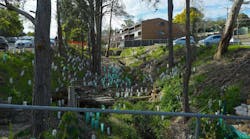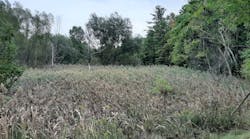Speaking of Dirt
With Phase II of the National Pollutant Discharge Elimination System (NPDES) in effect, the challenge for engineers, contractors, and developers now is to determine-and put to use-the best methods for controlling sediment at a job site.
According to Arthur Miner of A.J. Garrett and Associates, an erosion control company in West Des Moines, IA, sediment control has come a long way in the past few years yet still has a long way to go. “The people who should be involved are taking it much more seriously,” he says.While some municipalities are tightening up sediment control measures, others still seem to be sitting on the fence. “Now that we have Phase II kicking in, I’m seeing operations as usual, and that is too bad,” says Jerald Fifield, president of HydroDynamics Inc. in Parker, CO. “We can have a Phase II, a Phase III, and a Phase XX, and if we don’t have anymore enforcement out there, passing all of these additional laws isn’t going to matter at all.“The changes are beginning. Smaller municipalities are starting to pass rules so they don’t have [the Environmental Protection Agency] coming down on them. It’s fine to pass rules to protect the environment, but if we’re passing these rules, we’d better be ready to enforce the rules and have qualified inspectors and people who know what they’re looking for so we all can work together to minimize the amount of sediment pollution sites.”Fifield, who has written extensively about sediment control, points out a distinction: Dirt is what leaves an original site, and sedimentation is dirt causing problems because of where it ends up. “There is erosion control, there is sediment control, and then there is sedimentation. There are big distinctions. Sediment is particles suspended in runoff water that vary in size and shape and are a result of erosion that has occurred due to rainfall or other means.”Fifield notes that sediment control methods have been relatively ineffective for most suspended particles, except for particles “that are like large spans and have a heavier mass.”One technique used to deal with sediment in runoff is flocculation. “You add polyacrylamide [PAM], and it chemically bonds together suspended clay particles to make them larger so you can get a deposition to occur,” explains Fifield. “It is usually introduced as water is flowing to, say, a sediment containment system. It can also be introduced on hillsides, although the research is still out as to the effectiveness.” Fifield says the biggest drawback to using PAM effectively is that it has to be mixed with water and takes a lot of “tender, loving care” to make it work right. In addition, the wrong PAM can be detrimental to fish life downstream.When PAM is introduced, it increases the size and weight of the particles and can start developing an effective sediment containment system. The correct PAM is not toxic to fish.
Still the most effective sediment control measures are effective erosion control practices, Fifield says. “Essentially you have to do erosion [control] as you’re doing the construction process, compared to erosion control at the end of the construction process, which is different. Fortunately contractors and developers are finding out that implementing erosion control practices as the construction activities occur can be done in a cost-effective manner.”Aicardo Roa-Espinosa, an urban conservationist with Dane County Land Conservation in Wisconsin, notes that the goal of a sediment control plan is to deal with the problems on-site and that control and strict inspection help cut down on potential problems. He also is experienced with the use of flocculants for sediment control. “We don’t want soil loss to become sediment. Once you have sediment, you have to clarify the ponds of sediment with the use of coagulant and flocculent. It has to be a chemical treatment. And it’s very difficult.”Roa-Espinosa says Dane County is the only one in the country using a coagulant and flocculent for water clarification. He has developed a control measure using PAM.Practices vary throughout the country on what is being used for sediment control. Miner’s company previously used primarily silt fence for sediment control but now advocates other measures, such as berms, blankets, and matting, to provide the most efficiency for the dollars invested. Miner, a former Department of Transportation employee, does a great deal of work for the state, county, and city transportation departments. “The state is very serious about making [sediment control] effective, and that feeds down to counties and cities,” he says. “They’ll listen to our suggestions, but they have very stern policies they want to follow, and we have to bid accordingly.”For example, the company put in compost on 15 ac. of land and then applied a wood-fiber hydroseed mixture on top of it. “It’s kind of extreme, but it works for controlling sediment,” he says. “It was a steep slope on a freeway grading project that went into a river. We’ve used hydroseeding and hydromulching to keep sediment out of the river.”One of Miner’s company’s most challenging sediment control jobs involved a project near the Des Moines River. “The slopes were incredibly steep with loose soil, and we had to try to stop it,” he notes. The company laid down erosion matting and hydroseeded mulch. As it was a steep area, silt fences were placed adjacent to the other measures taken. Sales Manager Corey Simonpietri of Landsaver in Richmond, VA, says his company has changed its practices to become more proactive in the services it provides. Landsaver, which handles a variety of erosion control projects, is a division of ACF Environmental.Although the company has installed best management practices, with the contractor agreeing to maintain whatever was done, it is getting an increasing number of requests from clients-especially large homebuilding companies-for a regular system of inspections. “They don’t necessarily want to know every in and out, every code, and every regulation that has to be maintained on a site. They’re looking for somebody who can help them do that,” Simonpietri says.Landsaver is employing a variety of methods for sediment control, including Gutterbuddys, silt fences, erosion control blankets on drainage ditches during mass grading projects, and check dams or silt dikes in small drainage ditches.
“For example, most specifications call for cleaning a silt fence when it is half-full,” he says. “But the question is how to remove it and what to do with it. It just creates another problem. My belief is to leave it stored behind the device and build a new one to collect new runoff.”
Planning and budgeting of materials required for an erosion and sediment control plan is usually done on a per-linear-foot basis, industry specialists say, and the final costs depend on products used. But those costs are nothing compared to the fines levied for not using the methods.Fines and penalties can be hefty for violations, such as not controlling sediment that leaves a site or improperly maintaining sediment control measures. Roa-Espinosa says the most severe penalty for a violation is a stop-work order. “That hurts. There’s a lot of machinery and workers they’re keeping on it. That hurts more than any fine. We only fine people in extreme cases. If you stop a guy from working two or three days of the week, he really pays the price.”Roa-Espinosa says the county has found stop-work orders to be very effective because there are companies that get fined and still continue their same practices while paying the fine. Powers concurs, pointing out that a stop-work order can be even worse than a fine because it has a synergistic effect that impacts everyone-from the worker to the developer. In Powers’s area, those who violate regulations get warnings, with subsequent fines ranging from a few thousand dollars up to $10,000 for a repeated fine. Fifield says the Clean Water Act stipulates that violations for negligence carry a fine of $2,500-$50,000 per day of violation or one to two years in prison, with $50,000 fines reserved for repeat offenders. “Knowing violations”-acts done purposefully-result in a range of fines from $5,000 to $100,000 per day of violation and/or three to six years in prison. “Knowing dangerous” is a violation that can result in a $250,000-$1 million fine and/or 15 years in prison for a particular incident. The fine for making a false statement on an inspection report is $10,000-$20,000 and/or two to four years in prison. EPA has an administrative penalty that carries a daily fine of $10,000-$25,000. A Class-Two administrative penalty ranges from $10,000 to $125,000 a day. Fifield says “deep pockets” are being hit with significant fines, including many departments of transportation in Tennessee, Idaho, and California. EPA has made inspections nationwide and levied more than $1 million in fines against 12 entities because they did not have plans on-site. Many people with the CPESC-Certified Professional in Erosion and Sediment Control-designation, such as Carpenter and Fifield, or with similar certifications, find that it provides them with more clout. Simonpietri, who is not a CPESC and says Virginia does not do a lot with the CPESC program at this point, is in the process of becoming a certified inspector in Virginia. “It basically helps me talk in the same terminology they know, and the training background is similar. I’ve been in erosion control for more than 10 years, but that doesn’t always mean anything to somebody who’s on-site.”Fifield believes that because of their training and background, CPESCs often are more qualified than engineers. “It doesn’t mean that an engineer doesn’t know how to do it, but the regulatory people are making a huge mistake by saying only engineers sign plans. My opinion is that there ought to be a qualified person to sign plans, and if that turns out to be an engineer, fine. But if it turns out to be a CPESC, then that person ought to be able to sign the plans.” Fifield says there needs to be more communication and cooperation among designers and contractors on ensuring that the rules are followed. Contractors need to know that the cost of erosion and sediment control “is going to be cheap compared to the cost to clean up everybody’s mess on their properties and fight off all of the fines that are going to come down on you.”Journalist Carol Brzozowski writes on erosion control and technology.

